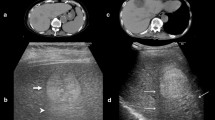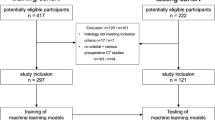Abstract
Purpose
To assess the methodological quality and to evaluate the predictive performance of radiomics studies for preoperative prediction of microvascular invasion (MVI) in hepatocellular carcinoma (HCC).
Methods
Publications between 2017 and 2021 on radiomic MVI prediction in HCC based on CT, MR, ultrasound, and PET/CT were included. The risk of bias was assessed using the prediction model risk of bias assessment tool (PROBAST). Methodological quality was assessed through the radiomics quality score (RQS). Fourteen studies classified as TRIPOD Type 2a or above were used for meta-analysis using random-effects model. Further analyses were performed to investigate the technical factors influencing the predictive performance of radiomics models.
Results
Twenty-three studies including 4947 patients were included. The risk of bias was mainly related to analysis domain. The RQS reached an average of (37.7 ± 11.4)% with main methodological insufficiencies of scientific study design, external validation, and open science. The pooled areas under the receiver operating curve (AUC) were 0.85 (95% CI 0.82–0.89), 0.87 (95% CI 0.83–0.92), and 0.74 (95% CI 0.67–0.80), respectively, for CT, MR, and ultrasound radiomics models. The pooled AUC of ultrasound radiomics model was significantly lower than that of CT (p = 0.002) and MR (p < 0.001). Portal venous phase for CT and hepatobiliary phase for MR were superior to other imaging sequences for radiomic MVI prediction. Segmentation of both tumor and peritumor regions showed better performance than tumor region.
Conclusion
Radiomics models show promising prediction performance for predicting MVI in HCC. However, improvements in standardization of methodology are required for feasibility confirmation and clinical translation.
Graphical abstract






Similar content being viewed by others
Abbreviations
- MVI:
-
Microvascular invasion
- HCC:
-
Hepatocellular carcinoma
- PROBAST:
-
Prediction model risk of bias assessment tool
- RQS:
-
Radiomics quality score
- AUC:
-
Area under the receiver operating characteristic
- PRISMA:
-
The preferred reporting items for systematic reviews and meta-analyses
- TP:
-
True positive
- TN:
-
True negative
- FP:
-
False positive
- FN:
-
False negative
- CT:
-
Computed tomography
- MRI:
-
Magnetic resonance imaging
- US:
-
Ultrasound
- PET:
-
Positron emission tomography
- TRIPOD:
-
Transparent reporting of a multivariable prediction model for individual prognosis or diagnosis
- N/l:
-
Number of training patterns of the smallest class/the number of selected features
- AP:
-
Arterial phase
- PVP:
-
Portal venous phase
- HBP:
-
Hepatobiliary phase
- ROI:
-
Region of interest
- ROB:
-
Risk of bias
References
Rodriguez-Peralvarez M, Luong TV, Andreana L, Meyer T, Dhillon AP, Burroughs AK (2013) A systematic review of microvascular invasion in hepatocellular carcinoma: diagnostic and prognostic variability. Ann Surg Oncol 20:325-339
Du M, Chen L, Zhao J, et al (2014) Microvascular invasion (MVI) is a poorer prognostic predictor for small hepatocellular carcinoma. BMC Cancer 14:38
Hirokawa F, Hayashi M, Miyamoto Y, et al (2014) Outcomes and predictors of microvascular invasion of solitary hepatocellular carcinoma. Hepatol Res 44:846-853
Mazzaferro V, Llovet JM, Miceli R, et al (2009) Predicting survival after liver transplantation in patients with hepatocellular carcinoma beyond the Milan criteria: a retrospective, exploratory analysis. Lancet Oncol 10:35-43
Lee S, Kang TW, Song KD, et al (2019) Effect of Microvascular Invasion Risk on Early Recurrence of Hepatocellular Carcinoma After Surgery and Radiofrequency Ablation. Ann Surg. DOI: https://doi.org/10.1097/SLA.000000000000326
Court CM, Harlander-Locke MP, Markovic D, et al (2017) Determination of hepatocellular carcinoma grade by needle biopsy is unreliable for liver transplant candidate selection. Liver Transpl 23:1123-1132
Banerjee S, Wang DS, Kim HJ, et al (2015) A computed tomography radiogenomic biomarker predicts microvascular invasion and clinical outcomes in hepatocellular carcinoma. Hepatology 62:792-800
Lee S, Kim SH, Lee JE, Sinn DH, Park CK (2017) Preoperative gadoxetic acid-enhanced MRI for predicting microvascular invasion in patients with single hepatocellular carcinoma. J Hepatol 67:526-534
Wang WT, Yang L, Yang ZX, et al (2018) Assessment of Microvascular Invasion of Hepatocellular Carcinoma with Diffusion Kurtosis Imaging. Radiology 286:571-580
Xu X, Zhang HL, Liu QP, et al (2019) Radiomic analysis of contrast-enhanced CT predicts microvascular invasion and outcome in hepatocellular carcinoma. J Hepatol 70:1133-1144
Yang L, Gu D, Wei J, et al (2019) A Radiomics Nomogram for Preoperative Prediction of Microvascular Invasion in Hepatocellular Carcinoma. Liver Cancer 8:373-386
Feng ST, Jia Y, Liao B, et al (2019) Preoperative prediction of microvascular invasion in hepatocellular cancer: a radiomics model using Gd-EOB-DTPA-enhanced MRI. Eur Radiol 29:4648-4659
Lambin P, Leijenaar R, Deist TM, et al (2017) Radiomics: the bridge between medical imaging and personalized medicine. Nat Rev Clin Oncol 14:749-762
Page MJ, McKenzie JE, Bossuyt PM, et al (2021) The PRISMA 2020 statement: an updated guideline for reporting systematic reviews. BMJ 372:n71
Collins GS, Reitsma JB, Altman DG, Moons KG (2015) Transparent reporting of a multivariable prediction model for individual prognosis or diagnosis (TRIPOD): the TRIPOD statement. BMJ 350:g7594
Moons K, Wolff RF, Riley RD, et al (2019) PROBAST: A Tool to Assess Risk of Bias and Applicability of Prediction Model Studies: Explanation and Elaboration. Ann Intern Med 170:W1-W33
Theodoridis S, Koutroumbas K (2009) Chapter 5 - Feature Selection. In: Theodoridis S, Koutroumbas K, ''editors'. Pattern Recognition (Fourth Edition). Boston: Academic Press: p. 261–322
D. F. (1972) Considerations of sample and feature size. Ieee T Inform Theory 18:618-626
Finette S, Bleier A, Swindell W (1983) Breast tissue classification using diagnostic ultrasound and pattern recognition techniques: I. Methods of pattern recognition. Ultrason Imaging 5:55-70
Debray TP, Damen JA, Snell KI, et al (2017) A guide to systematic review and meta-analysis of prediction model performance. BMJ 356:i6460
Suh CH, Park SH (2016) Successful Publication of Systematic Review and Meta-Analysis of Studies Evaluating Diagnostic Test Accuracy. Korean J Radiol 17:5-6
Deeks JJ, Macaskill P, Irwig L (2005) The performance of tests of publication bias and other sample size effects in systematic reviews of diagnostic test accuracy was assessed. J Clin Epidemiol 58:882-893
Kreuzberger N, Damen JA, Trivella M, et al (2020) Prognostic models for newly-diagnosed chronic lymphocytic leukaemia in adults: a systematic review and meta-analysis. Cochrane Database Syst Rev. 7:D12022
Bakr S, Echegaray S, Shah R, et al (2017) Noninvasive radiomics signature based on quantitative analysis of computed tomography images as a surrogate for microvascular invasion in hepatocellular carcinoma: a pilot study. J Med Imaging (Bellingham) 4:41303
Zheng J, Chakraborty J, Chapman WC, et al (2017) Preoperative Prediction of Microvascular Invasion in Hepatocellular Carcinoma Using Quantitative Image Analysis. J Am Coll Surg 225:778-788
Peng J, Zhang J, Zhang Q, Xu Y, Zhou J, Liu L (2018) A radiomics nomogram for preoperative prediction of microvascular invasion risk in hepatitis B virus-related hepatocellular carcinoma. Diagn Interv Radiol 24:121-127
Ma X, Wei J, Gu D, et al (2019) Preoperative radiomics nomogram for microvascular invasion prediction in hepatocellular carcinoma using contrast-enhanced CT. Eur Radiol 29:3595-3605
Ni M, Zhou X, Lv Q, et al (2019) Radiomics models for diagnosing microvascular invasion in hepatocellular carcinoma: which model is the best model? Cancer Imaging 19:60
He M, Zhang P, Ma X, He B, Fang C, Jia F (2020) Radiomic Feature-Based Predictive Model for Microvascular Invasion in Patients With Hepatocellular Carcinoma. Front Oncol 10:574228
Jiang YQ, Cao SE, Cao S, et al (2020) Preoperative identification of microvascular invasion in hepatocellular carcinoma by XGBoost and deep learning. J Cancer Res Clin Oncol. DOI:https://doi.org/10.1007/s00432-020-03366-9
Zhang X, Ruan S, Xiao W, et al (2020) Contrast-enhanced CT radiomics for preoperative evaluation of microvascular invasion in hepatocellular carcinoma: A two-center study. Clin Transl Med 10:e111
Men S, Ju H, Zhang L, Zhou W (2019) Prediction Of Microvascular Invasion Of Hepatocellar Carcinoma With Contrast-Enhanced MR Using 3D CNN And LSTM. IEEE 16th International Symposium on Biomedical Imaging 810–813
Zhang R, Xu L, Wen X, et al (2019) A nomogram based on bi-regional radiomics features from multimodal magnetic resonance imaging for preoperative prediction of microvascular invasion in hepatocellular carcinoma. Quant Imaging Med Surg 9:1503-1515
Zhu YJ, Feng B, Wang S, et al (2019) Model-based three-dimensional texture analysis of contrast-enhanced magnetic resonance imaging as a potential tool for preoperative prediction of microvascular invasion in hepatocellular carcinoma. Oncol Lett 18:720-732
Nebbia G, Zhang Q, Arefan D, Zhao X, Wu S (2020) Pre-operative Microvascular Invasion Prediction Using Multi-parametric Liver MRI Radiomics. J Digit Imaging. DOI:https://doi.org/10.1007/s10278-020-00353-x
Wilson GC, Cannella R, Fiorentini G, et al (2020) Texture analysis on preoperative contrast-enhanced magnetic resonance imaging identifies microvascular invasion in hepatocellular carcinoma. HPB (Oxford) 22:1622-1630
Chong HH, Yang L, Sheng RF, et al (2021) Multi-scale and multi-parametric radiomics of gadoxetate disodium-enhanced MRI predicts microvascular invasion and outcome in patients with solitary hepatocellular carcinoma ≤ 5 cm. Eur Radiol. DOI: https://doi.org/10.1007/s00330-020-07601-2
Zhang S, Xu G, Duan C, et al (2021) Radiomics Analysis of MR Imaging with Gd-EOB-DTPA for Preoperative Prediction of Microvascular Invasion in Hepatocellular Carcinoma: Investigation and Comparison of Different Hepatobiliary Phase Delay Times. Biomed Res Int 2021:6685723
Yao Z, Dong Y, Wu G, et al (2018) Preoperative diagnosis and prediction of hepatocellular carcinoma: Radiomics analysis based on multi-modal ultrasound images. BMC Cancer 18:1089
Dong Y, Wang QM, Li Q, et al (2019) Preoperative Prediction of Microvascular Invasion of Hepatocellular Carcinoma: Radiomics Algorithm Based on Ultrasound Original Radio Frequency Signals. Front Oncol 9:1203
Hu HT, Wang Z, Huang XW, et al (2019) Ultrasound-based radiomics score: a potential biomarker for the prediction of microvascular invasion in hepatocellular carcinoma. Eur Radiol 29:2890-901
Dong Y, Zhou L, Xia W, et al (2020) Preoperative Prediction of Microvascular Invasion in Hepatocellular Carcinoma: Initial Application of a Radiomic Algorithm Based on Grayscale Ultrasound Images. Front Oncol 10:353
Li Y, Zhang Y, Fang Q, et al (2021) Radiomics analysis of [(18)F]FDG PET/CT for microvascular invasion and prognosis prediction in very-early- and early-stage hepatocellular carcinoma. Eur J Nucl Med Mol Imaging. DOI: https://doi.org/10.1007/s00259-020-05119-9
Steyerberg EW, Vickers AJ, Cook NR, et al (2010) Assessing the performance of prediction models: a framework for traditional and novel measures. Epidemiology 21:128-138
Sauerbrei W, Taube SE, McShane LM, Cavenagh MM, Altman DG (2018) Reporting Recommendations for Tumor Marker Prognostic Studies (REMARK): An Abridged Explanation and Elaboration. J Natl Cancer Inst 110:803-11
Nagendran M, Chen Y, Lovejoy CA, et al (2020) Artificial intelligence versus clinicians: systematic review of design, reporting standards, and claims of deep learning studies. BMJ 368:m689
Zhong J, Hu Y, Si L, et al (2020) A systematic review of radiomics in osteosarcoma: utilizing radiomics quality score as a tool promoting clinical translation. Eur Radiol. DOI: https://doi.org/10.1007/s00330-020-07221-w
Granzier R, van Nijnatten T, Woodruff HC, Smidt ML, Lobbes M (2019) Exploring breast cancer response prediction to neoadjuvant systemic therapy using MRI-based radiomics: A systematic review. Eur J Radiol 121:108736
Ursprung S, Beer L, Bruining A, et al (2020) Radiomics of computed tomography and magnetic resonance imaging in renal cell carcinoma-a systematic review and meta-analysis. Eur Radiol 30:3558-3566
Huang M, Liao B, Xu P, et al (2018) Prediction of Microvascular Invasion in Hepatocellular Carcinoma: Preoperative Gd-EOB-DTPA-Dynamic Enhanced MRI and Histopathological Correlation. Contrast Media Mol Imaging 2018:9674565
Roayaie S, Blume IN, Thung SN, et al (2009) A system of classifying microvascular invasion to predict outcome after resection in patients with hepatocellular carcinoma. Gastroenterology 137:850-855
Funding
This study has received funding by National Natural Science Foundation of China (No. 81530055 and 81901768).
Author information
Authors and Affiliations
Corresponding authors
Ethics declarations
Conflict of interest
The authors have no relevant financial or non-financial interests to disclose.
Ethical approval
Review Board approval was not required because this study was a systematic review and meta-analysis using data from published studies.
Informed consent
Written informed consent was not required for this study because this study was a systematic review and meta-analysis using data from published studies.
Additional information
Publisher's Note
Springer Nature remains neutral with regard to jurisdictional claims in published maps and institutional affiliations.
Supplementary Information
Below is the link to the electronic supplementary material.
Rights and permissions
About this article
Cite this article
Zhong, X., Long, H., Su, L. et al. Radiomics models for preoperative prediction of microvascular invasion in hepatocellular carcinoma: a systematic review and meta-analysis. Abdom Radiol 47, 2071–2088 (2022). https://doi.org/10.1007/s00261-022-03496-3
Received:
Revised:
Accepted:
Published:
Issue Date:
DOI: https://doi.org/10.1007/s00261-022-03496-3




